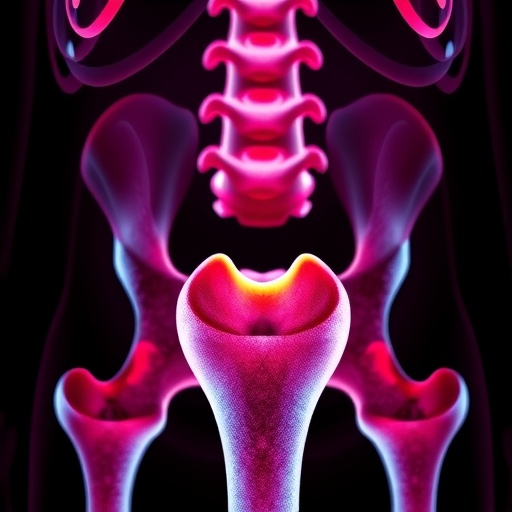In a groundbreaking discovery that could redefine the therapeutic landscape of osteosarcoma, researchers have identified critical gene signatures intimately linked to the stemness of tumor cells. The study, published in BMC Cancer, meticulously dissects the molecular underpinnings that dictate tumor progression, immune interaction, and ultimately patient prognosis. This research uncovers the pivotal role of the gene S100A13, a finding that promises to spur the development of innovative diagnostic and treatment modalities tailored for osteosarcoma—one of the most aggressive bone cancers predominantly affecting young individuals.
Osteosarcoma, characterized by malignant bone tumor cells, often exhibits resistance to conventional treatments, largely due to the presence of cancer stem cells. These cells possess the ability to self-renew and differentiate, contributing to tumor heterogeneity and complexity. Leveraging advanced single-cell RNA sequencing (scRNA-seq) technology, the researchers cataloged the gene expression profiles of osteosarcoma tumor cells with unprecedented resolution. This approach enabled the isolation of a subset of cancer cells marked by elevated stemness characteristics, foreshadowing their potential involvement in tumor aggressiveness and recurrence.
The study’s comprehensive approach extended beyond mere identification. By delineating differentially expressed genes (DEGs) within this high-stemness cluster, investigators constructed a prognostic model capable of stratifying patients according to risk. This model distinguishes patients with high-risk scores—those predicted to have poorer outcomes—from those with comparatively favorable prognoses. This stratification echoes clinically relevant variations in the tumor microenvironment, particularly in immune cell infiltration patterns, revealing a nuanced interplay between tumor biology and host immunity.
Intriguingly, the high-risk cohort demonstrated distinct mutation landscapes and enriched molecular pathways that underpin malignancy. These pathways suggest an active remodeling of the tumor ecosystem, influenced by the dynamics of stemness-associated gene expression. Notably, immune profiling of tumor samples revealed significant differences in immune cell composition between high- and low-risk groups, implicating stemness genes in modulating patient responsiveness to immunotherapeutic interventions.
A keystone of this research was the pinpointing of S100A13 as a master regulator within the stemness gene signature. Employing cross-enrichment analyses, the gene emerged as uniquely upregulated in prognostically adverse groups and the high-stemness cluster. Functional assays in vitro provided compelling evidence: silencing S100A13 in osteosarcoma cell lines MG-63 and HOS markedly impaired cell proliferation, colony formation, and the capacity to form tumor spheres—hallmarks of malignancy and stem-like traits.
Beyond proliferation, S100A13 knockdown exerted profound effects on cellular motility and invasiveness. Wound healing assays, migration chambers, and invasion models consistently demonstrated reduced aggressive behavior of osteosarcoma cells deficient in S100A13. This highlights a multifaceted role for this gene, orchestrating not only self-renewal but also metastatic potential, positioning it as a linchpin in osteosarcoma pathobiology.
The identification of S100A13 as a critical driver gene presents a tantalizing target for therapeutic development. Unlike conventional therapies that indiscriminately attack proliferating cells, targeting S100A13 could hone in on the root of tumor regeneration and metastasis—the cancer stem cell population—offering a strategic advantage in mitigating relapse and improving long-term survival.
Moreover, the prognostic power of the stemness risk score integrating S100A13 and allied gene signatures furnishes clinicians with a robust tool for risk assessment. This could guide personalized treatment regimens, optimizing the deployment of surgery, chemotherapy, and emerging immunotherapies, based on a patient’s molecular profile.
Equally significant is the implication of immune infiltration patterns linked with the stemness characteristics. The altered immune milieu in high-risk tumors underscores the necessity to understand how stemness influences immune evasion and response. Future research could elucidate mechanisms by which S100A13 and related genes modulate immune checkpoints or alter antigen presentation, informing combination therapies capitalizing on immunomodulation.
The methodology encompassing single-cell transcriptomic analysis and subsequent integrative bioinformatics demonstrates the power of cutting-edge molecular technologies to unravel tumor complexity. In dissecting the heterogeneity of osteosarcoma at cellular resolution, this study sets a precedent for similar investigations in other malignancies where stemness dictates clinical outcomes.
Importantly, the research bridges molecular findings with functional validations, impressively moving from genomics to biology. This translational approach ensures that discoveries are anchored in physiological relevance, accelerating the path from bench to bedside.
In the context of broader cancer research, the study of S100A13 opens avenues for exploring its role in other cancers exhibiting stem-like traits and aggressive phenotypes. Given the conserved nature of stemness pathways, such findings could resonate across oncologic disciplines, enabling a unified strategy against cancer stem cells.
Finally, this research champions a precision medicine outlook, advocating for biomarker-driven therapeutic decision-making in osteosarcoma. As the oncology field strides towards individualized treatments, integrating gene signatures like that of S100A13 into clinical workflows could transform prognosis accuracy and treatment efficacy, offering hope to patients grappling with this formidable disease.
This landmark study not only advances our understanding of osteosarcoma biology but also ignites optimism for novel interventions. The identification and validation of stemness-related gene signatures, with S100A13 at the crux, exemplify how molecular science can unravel cancer’s mysteries and forge pathways to curative strategies.
Subject of Research: Identification and validation of stemness-related gene signatures in osteosarcoma and their prognostic significance, focusing on the gene S100A13.
Article Title: Identification and validation of stemness-related gene signatures to predict prognosis and immune infiltration in osteosarcoma reveals a critical role for S100A13.
Article References:
Li, J., Chang, C., Ma, Y. et al. Identification and validation of stemness-related gene signatures to predict prognosis and immune infiltration in osteosarcoma reveals a critical role for S100A13.
BMC Cancer 25, 1734 (2025). https://doi.org/10.1186/s12885-025-14939-7
Image Credits: Scienmag.com
DOI: 08 November 2025




